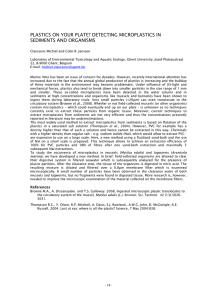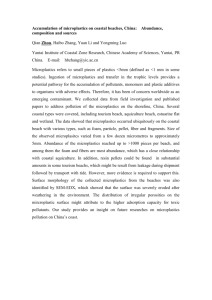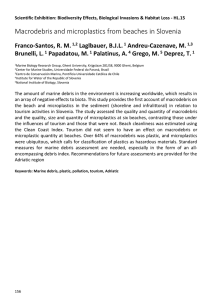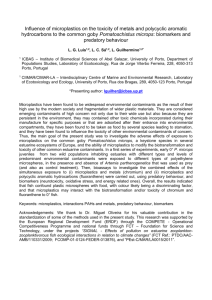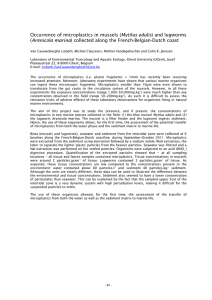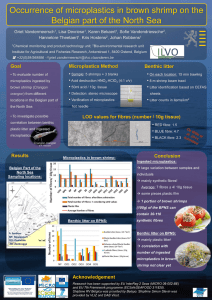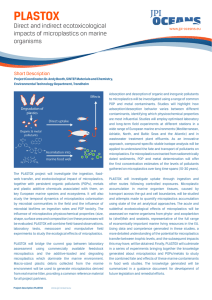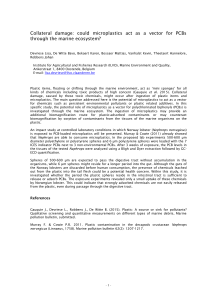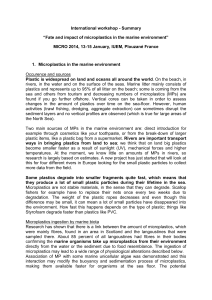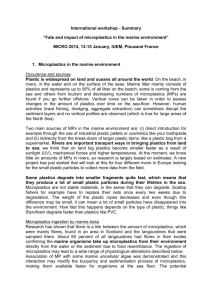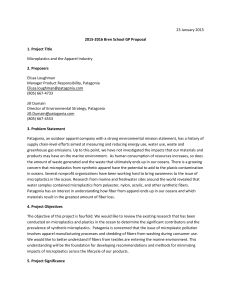MARMICROTOX project: effects of microplastics in marine
advertisement
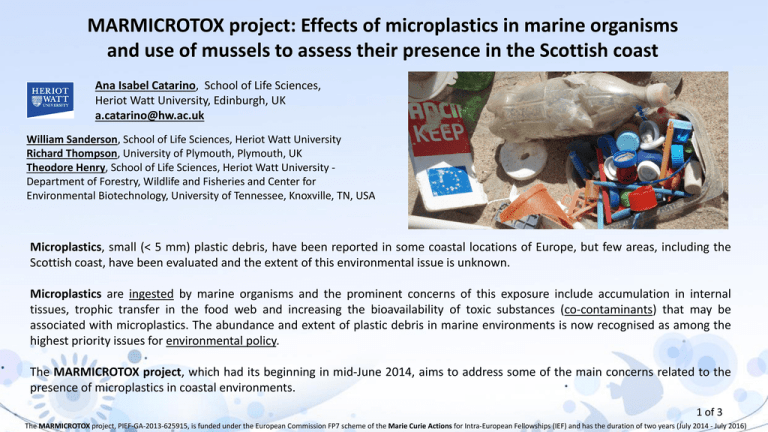
MARMICROTOX project: Effects of microplastics in marine organisms and use of mussels to assess their presence in the Scottish coast Ana Isabel Catarino, School of Life Sciences, Heriot Watt University, Edinburgh, UK a.catarino@hw.ac.uk William Sanderson, School of Life Sciences, Heriot Watt University Richard Thompson, University of Plymouth, Plymouth, UK Theodore Henry, School of Life Sciences, Heriot Watt University Department of Forestry, Wildlife and Fisheries and Center for Environmental Biotechnology, University of Tennessee, Knoxville, TN, USA Microplastics, small (< 5 mm) plastic debris, have been reported in some coastal locations of Europe, but few areas, including the Scottish coast, have been evaluated and the extent of this environmental issue is unknown. Microplastics are ingested by marine organisms and the prominent concerns of this exposure include accumulation in internal tissues, trophic transfer in the food web and increasing the bioavailability of toxic substances (co-contaminants) that may be associated with microplastics. The abundance and extent of plastic debris in marine environments is now recognised as among the highest priority issues for environmental policy. The MARMICROTOX project, which had its beginning in mid-June 2014, aims to address some of the main concerns related to the presence of microplastics in coastal environments. 1 of 3 The MARMICROTOX project, PIEF-GA-2013-625915, is funded under the European Commission FP7 scheme of the Marie Curie Actions for Intra-European Fellowships (IEF) and has the duration of two years (July 2014 - July 2016) Priority issues that require investigation include: 1) Evaluation of the extent of microplastics pollution in marine organisms (mussels) in different locations in Scotland 2) Investigation of the accumulation, absorption and negative effects of microplastics in lower trophiclevel marine invertebrates (mussels) 3) Determination of effects of microplastics on co-contaminant bioavailability in marine organisms (mussels) 4) Examination of trophic transfer of microplastics and pathophysiology in fish 5) Development of various science outreach activities aiming to engage the general public on the microplastics issue 1 2 3 4 5 Time 2Y 1) In the first stage, our goal is to assess abundance and type of microplastics in wild mussels collected from sites located in both the East and West coast of Scotland. We are currently evaluating and quantifying the presence of microplastics in mussels within the Mytilidae family: horse mussels, Modiolus modiolus (a subtidal filter feeder) and blue mussels Mytilus edulis (intertidal filter feeder). We have developed an extraction and quantification method and applied it to individuals collected along the Scottish coast (Atlantic and North Sea). M. modiolus 2 of 3 The MARMICROTOX project, PIEF-GA-2013-625915, is funded under the European Commission FP7 scheme of the Marie Curie Actions for Intra-European Fellowships (IEF) and has the duration of two years (July 2014 - July 2016) 2) In the second stage, this study will focus on evaluation of microplastic accumulation, absorption and negative effects, including physical tissue disruption, on the mussel M. edulis. 3) The project will further assess whether association between co-contaminants and microplastics influences co-contaminant bioavailability in mussels. 4) Finally, we will artificially expose sea trout individuals (brown trout, Salmo trutta) to food items containing known amounts of microplastics. The goal is to investigate the trophic transfer of microplastics by dietary exposure in S. trutta and the effects on tissue surfaces, digestive system physiology, as well as overall organism health including growth and food conversion efficiency. 5) Aiming to contribute to raise general awareness of the plastic litter problem in the oceans, MARMICROTOX will include science outreach activities such as: a) Creation of a website (http://marmicrotox.blogspot.co.uk) and of Twitter content (@Zebrazuli) b) Participation in school activities by collaborating Native Scientist activities and on open days and science fairs organised by the Heriot-Watt Public Engagement department c) Volunteer as a role model on the European Commission campaign, Science: It’s a Girl Thing 3 of 3 The MARMICROTOX project, PIEF-GA-2013-625915, is funded under the European Commission FP7 scheme of the Marie Curie Actions for Intra-European Fellowships (IEF) and has the duration of two years (July 2014 - July 2016)
